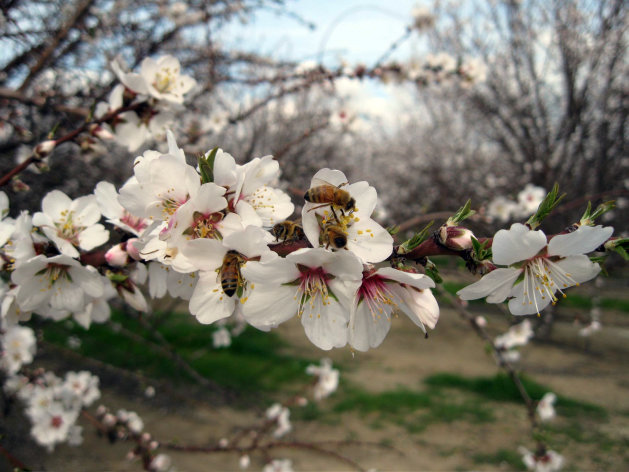
This summer in Merced County, Enns
brokered the sale of 1,200 acres of open ground lacking a good source
of water. Listed at $12,500 per acre, the land attracted dozens of
buyers and sold within a month for a whopping $15,000 per acre. The
buyer will plant it with almond trees, a notably water-intensive crop.
"It was one of the highest sales per acre that we've seen for that
kind of land," said Enns, vice president of the Farm Lands Department at
Pearson Realty. "We've seen some numbers that would just blow your
mind."
In recent years, farmers in California's
Central Valley have seen record-high revenues, buoyed by high demand
for fruits, nuts and vegetables in the U.S. and abroad. Investors both
foreign and domestic have taken notice, buying up farmland and driving
up agricultural land values in a region with some of the highest residential foreclosure rates.
California's almond industry,
which grows about 80 percent of the global almond supply and 100 percent
of the domestic supply, saw the most dramatic growth — powered by
strong demand from new money-spending middle classes in India and China.
The growth has prompted a rush for almond-growing land and pushed
almond land values through the roof.
Farmland prices have been mostly rising for the past decade
throughout the U.S., according to the U.S. Department of Agriculture.
But over the past three years, despite the recession, they reached
record highs.
"A lot of people thought values in farmland would drop like the values in housing," said Allan Barros,
a Fresno-area appraiser. "But the sellers ... sat on their properties
and farmland values didn't budge. Everybody gave a sigh of relief."
Then land values went sharply up, Barros said, pushed by rising
agricultural revenues. In this region with the highest farm receipts in
the nation, prices for most commodities rose dramatically. Revenues for
almonds and walnuts increased by 30 percent between 2010 and 2011, and
revenues for grapes rose by 20 percent, according to the USDA.
California's agricultural exports during that time grew by more than $3
billion.In 2011, for the first time, the value of California's almond crop surpassed the state's iconic grape industry to move into second place, behind dairy, as the state's top commodity. Almond producers increased their productivity and their orchard sizes, and shipments more than doubled over the past 10 years, according to the California Almond Board. During the 2011-2012 crop year, California farmers brought in $3.9 billion in revenue.
Almonds also became the top export, outpacing dairy and wine, mostly due to increased demand from Asia and a weak dollar, almond producers say. Two-thirds of the almonds produced today are shipped overseas.
Real estate experts say farmers and other investors wanting to cash in on that growth quickly cleared the inventories of available nut land. With little else to buy, they ripped out vineyards and other crops to plant almond orchards. Almonds — which grow from Red Bluff to Bakersfield — increased by over 100,000 acres since 2008, to 760,000 total bearing acres today, according to the Almond Board.
Scarcity of available almond land is also pushing some investors to plant trees in areas with a poorer water supply or less appropriate soil. Since nut trees take several years to mature, time will tell whether the risks were worth taking, said Barros, the appraiser.
New investors range from local farmers trying to expand their orchards to international companies seeking high returns on prime almond farmland, experts say. Pension funds, insurance companies and retirement funds also are investing portions of their portfolios into agriculture. Olam International, a Singapore-based commodities supplier, farms 7,000 acres of almonds in California.
Nut land — almond, pistachio and walnut — is now the highest valued type in every county throughout the valley, according to the American Society of Farm Managers and Rural Appraisers' California chapter.
In Fresno County, almond land was
valued at up to $18,000 per acre in 2012, and pistachio land at up to
$25,000 per acre. That's higher than citrus, grape, or tree fruit land
—and much higher than the $7,200 average per acre farm real estate value
in California last year, according to the USDA.
Putting money in farmland pays
off, said Biff Ourso, portfolio manager at the New York-based financial
services firm TIAA-CREF, because it can generate an income and
appreciate over time. But it also brings much-needed diversification.
"Farmland doesn't behave in the
same pattern as other traditional asset classes," Ourso said, which
means it reduces the risk for investors in case of a market downturn.
Investing in agriculture is
attractive in the long term, he said, because of the growing world
population, expanding middle classes and the fact that farmland is a
finite resource. The company — which manages about 140,000 acres of
farmland in the U.S., including almonds in California — leases its farm
properties to farmers.
Local almond operators say heightened interest from investors spells out a bright outlook.
"There's lots of excitement in the industry," said Jim Crecelius, CEO of Montavista Farming Company based in Hanford.
Crecelius, an almond farmer, also
processes the nuts for investors throughout the Valley and markets them
in Asia. "We have never been able to completely supply every almond
that our customers need," he said.
Some worry that the almond investment boom could lead to overproduction and hurt local farmers.
"Everybody in the industry is
continually asking: are we in a bubble or is this a change of
economies?" said Chuck Nichols, who farms over 1,000 acres of almonds
and pistachios in Tulare and Kings counties. "We don't know the answer
to that."

No comments:
Post a Comment